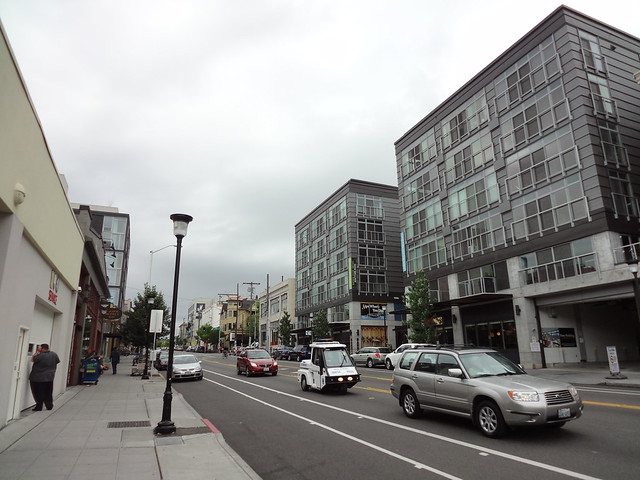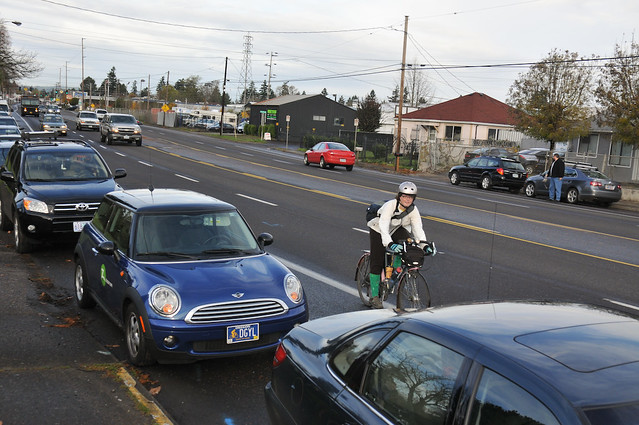
(Photo: Adam Coppola)
Here’s one way to think about the political battle over housing in growing cities, spelled out Monday at an Oregon Active Transportation Summit panel: it’s got three main interest groups.
One group is social-justice advocates and tenants. These people are generally interested in keeping prices lower one way or another, especially for the lowest-income people.
One group is environmentalists, businesses and the development industry. These people are (for various reasons) generally interested in increasing the number of people living in the city.
The third group is a highly active subset of single-family homeowners. These people are generally interested in maintaining or increasing the value of their property, especially while keeping things the way they were when they bought it.
At an OATS panel Monday, environmentalist Alan Durning of the Seattle-based Sightline Institute proposed this way of thinking about housing politics. Then he used it to describe Seattle’s situation, and the unusual way the city has been responding to it.
“The previous status quo in Seattle around housing issues is a coalition that I sometimes refer to as the NIMBY-Trotsky coalition,” Durning said with tongue somewhat in cheek. “The social justice community essentially aligned with the homeowner community because of concerns about displacement. And the affordable housing community — that is, the providers of affordable housing — didn’t want to upset their donors and voters.”
“You think things are expensive in Portland, right? Multiply everything by 50 percent.”
— Alan Durning, Sightline Institute
In the short term, Durning said, that political “equilibrium” made everyone happy. But over years and decades, it pointed in one direction: a huge housing shortage.
“The long-term effect of this is to make housing in Seattle astronomically expensive,” Durning said. “You think things are expensive in Portland, right? Multiply everything by 50 percent. … We have to do something, or we’ll end up with a truly San Francisco situation.”
So, Durning said, Seattle’s social-justice advocates and housing-supply advocates teamed up to propose a so-called “grand compromise” that aimed to build a new coalition of their own that would, over time, drive prices down rather than up.
As Portland contemplates a similar fate — and gets close to a similar conversation of its own over the next year or so — the panel asked the question: what role will these interest groups play here?
HALA’s key breakthrough: Upzones plus inclusionary zoning

(Photo: Paul Sableman)
In Durning’s account, Seattle’s sheaf of housing recommendations — known as the Housing Affordability and Livability Agenda, or HALA — required 10 months of closed-door negotiation and almost collapsed completely.
“We need to handcuff the two to each other: density and affordability.”
— Alan Durning
“Eight months into this process, everyone was convinced it was going to lead to nothing, and in the last two months a very surprising set of recommendations emerged,” Durning said. “The first is that we need more housing: not a little but a lot more housing. … The second is that we need to do that in a way that steers the growth toward density and affordability. In fact, we need to handcuff the two to each other: density and affordability.”
The issue was certainly pressing. Last year, Durning wrote that during his 10 months on HALA’s 28-member advisory committee, the assessed value of his own house had inflated $100,000.
By the end of it, Durning said, the committee hit on a key bargain: allow more density everywhere in Seattle, but use conditional mandatory inclusionary zoning to guarantee that all the upzones in multifamily areas include units that would be affordable to people making less than 60 percent of median income.
“The kernel at the center of the HALA plan is a recommendation to basically upzone the whole city — not literally upzone the single-family zones, but create more flexibility in them — but [as] part of that, in every one of those upzones there would be a mandate that developers provide a certain percentage of units in each building,” Durning said. “This would produce way way way more affordable-rate units and way more market rate units than anything on the table before.”
If the plan simply put inclusionary zoning on every property without upzoning it, fewer developments would have been profitable and infill might have stopped — which would have also stopped production of low-cost units, because inclusionary zoning only applies to new buildings. Instead, the citywide upzone allowed developers to build one more floor on many buildings, but — once that “upzone” has been completed — it essentially requires them to use the profits from that top story to subsidize the lower-rent units.
Despite media backlash, Seattle voters back affordability-coalition candidates

(Photo: Seattle City Council)
When the HALA committee’s recommendations went public, Durning said they caused a “huge fight in the press.”
The lightning rod was the committee’s finding that single-family zoning in Seattle (like in all U.S. cities) was rooted in the desire of early 20th century homeowners to keep non-white and poor people out of their areas.
“It led to a huge, huge outpouring of opposition and so on just before there was a primary election,” Durning said. “If you looked at the media or attended community meetings, your assumption was going to be all our recommendations were going to die.”
In the firestorm, Durning said, Seattle’s mayor and council backed off from some of the recommended changes to single-family neighborhoods.
“But what happened next was very interesting,” he went on. “The organizations that had their interests reflected in HALA began to find each other and form their own coalitions.”
Advertisement
Durning said HALA has given groups including unions, urbanist environmental groups and affordability advocates a banner to unite around. And he said they have united, notably in a new group called Seattle for Everyone.
“Now, many of the key community meetings and much of the media coverage in the city, there are two voices in much of the debates that have been dominated by neighborhood preservationists,” Durning said. “We’ll also have someone who stands up and says, ‘I work in the city of Seattle and I’d like to be able to live there.”
After last fall’s elections, Durning said, “the politics have shifted.”
“The candidates who latched their futures to the neighborhood preservation impulse mostly got clobbered,” Durning said. “The lesson that people in the political establishment in Seattle took from that is, Oh, you have to be careful when you’re talking about changing neighborhoods, but it’s not a third rail, and it’s not going to kill you.”
Durning warned that the battle for more and cheaper housing in Seattle won’t be won until the city has finished the mass upzone, which it’s trying to complete one neighborhood at a time.
“It’s going to require an unbelievable organizing effort,” Durning said. “The only reason we can believe that can work is if we can hold that political coalition together for everyone from the chamber of commerce to the social justice advocates.”
Portland panelists see local parallels and differences

(Photo: J.Maus/BikePortland)
Sharing the panel with Durning Monday were two Portland housing experts: Justin Buri of the Community Alliance of Tenants and Housing Land Advocates, and Katherine Schultz of GBD Architects and the Portland Planning and Sustainability Commission.
Both agreed that some measures similar to Seattle’s might be useful in Portland.
Buri criticized zoning restrictions such as “floor area ratio and minimum lot size that are only there to preserve the value or increase the value of that home and create enclaves of wealth.”
Schultz said her architecture firm has found that the main way to build homes more cheaply is to build them smaller.
“Really, the only thing that we’ve been able to spur is making units smaller and more efficiently designed,” Schultz said. “You have a market out there that’s based on cost per square foot.”
Schultz said she completely agreed with the need to hold down housing prices, both by building more market-rate housing and by finding ways to make it profitable for developers to offer below-market housing.
Buri — who raised his hand, grinning, when Durning mentioned the “far left who don’t believe anyone should be making money on real estate” — questioned whether Durning’s “NIMBY-Trotsky coalition” is as strong in Portland as it has been in Seattle.
“It is supply and demand, but that doesn’t mean that if you’re a low-income tenant that’s being displaced from your home, taking an economics 101 class could help you avoid that.”
— Justin Buri, Community Alliance of Tenants
“It’s dangerous to paint opposition with broad strokes,” Buri said. “We see first-time homeowner opportunities being demolished for $800,000 McMansions, which doesn’t do anything for density or affordability.” Objecting to one-for-one demolitions, Buri said, is very different than objecting to construction because it changes “neighborhood character.”
Buri also called for Portland to work harder to include groups like OPAL Bus Riders Unite in its planning processes and to make affordable housing the first priority in a publicly backed development plan rather than the last.
And he noted that for all the talk of economics, understanding the causes of Portland’s housing shortage and price spikes isn’t enough to fix them.
“I am getting more and more frustrated with the simple refrain it’s just supply and demand,” Buri said. “It is supply and demand, but that doesn’t mean that if you’re a low-income tenant that’s being displaced from your home, taking an economics 101 class could help you avoid that.”
The Real Estate Beat is a regular column. You can sign up to get an email of Real Estate Beat posts (and nothing else) here, or read past installments here.
— Michael Andersen, (503) 333-7824 – michael@bikeportland.org
BikePortland can’t survive without subscribers. It’s just $10 per month and you can sign up in a few minutes.



